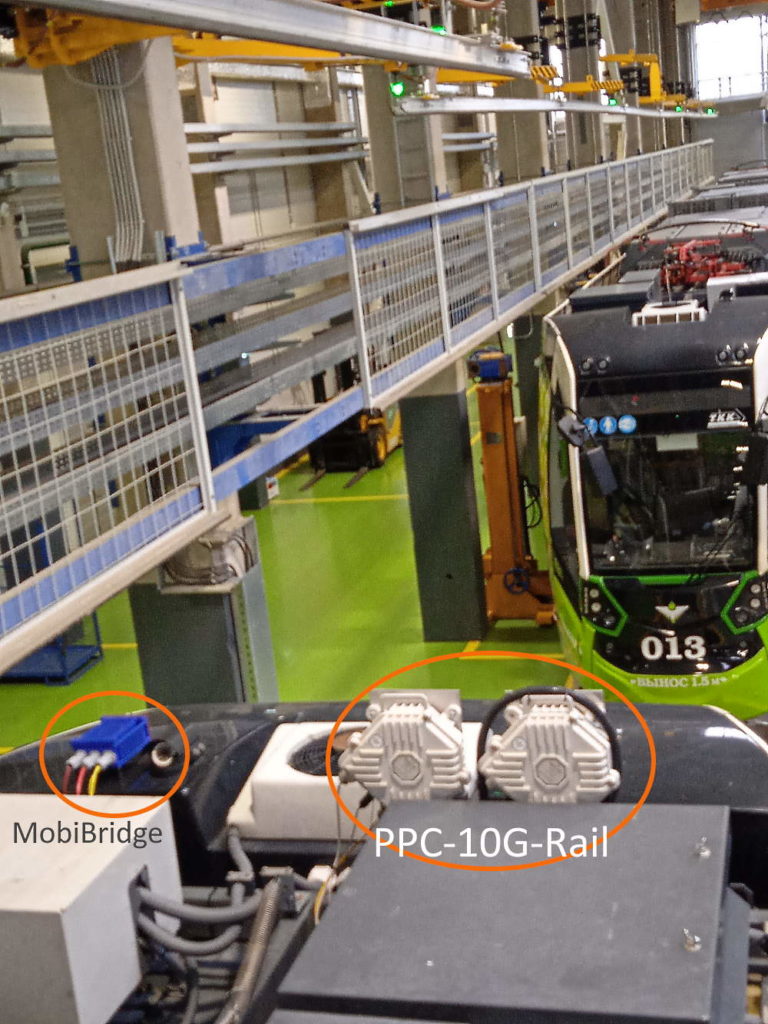
For the first time in the industry, next-generation 10 Gbps wireless communications are being tested for a light rail. This testing of V2N (Vehicle to Network) connectivity is aimed at the development of digital ecosystems in public transport. The project is being implemented in cooperation with the light rail operator.
ELVA-1 has announced the testing of PPC-10G-Rail 10-gigabit wireless communication system operating in the 70-80 GHz (71-76 / 81-86 GHz) band is being carried out on the light rail routes. The purpose of the tests is to develop ultra-broadband communication technologies between a network and moving vehicles (V2N), analyze the characteristics of a wireless connection and its availability at various distances between the rail transport and base stations, and also to collect traffic statistics for various weather conditions.
The existing technologies for connecting rail transport to the Internet (train-to-ground) are widely based on the use of GSM modems. In some of the projects, a network of roadside Wi-Fi access points is used. Both technologies are characterized by low connection speed (up to 300 Mbps) and handshaking delays when switching from one base station to another.
Also, the connection for both the GSM modem (or a roadside Wi-Fi network) suffers a significant degradation as the vehicle speed increases. This is why the task of designing communication with high-speed rail transport based on new technologies is very actual in the transportation industry and railways.
At May 2022, the project was at the stage of main tests. The test report confirm the ability to transfer data in the E-band 70-80 GHz between the vehicle and the operator’s network at a speed of 10 to 15 Gbps over the distance of about 1 km. The connection of the vehicle to network is carried out according to the V2N concept (Vehicle to Network) as a special case of the more general V2X (Vehicle to Everything) connection scheme.
The cyclic route of the urban light rail transport along the base stations is convenient for gaining connection statistics in real urban environment. Subsequently, these technologies will become applicable for high-speed trains on the railways worldwide, where the problem of a gigabit connection to the Internet is even more actual.
For testing, the three-section tram was equipped with four 10 Gbps transceivers, installed on the roof of the vehicle in the head and rear of the tram. The average distance between base stations in the tests is 800 to 1000 meters (0.5 to 0.62 miles).
A specialized controller is mounted under the ceiling inside the tram for routing and traffic management of the wireless connection to the operator’s network. The presence of two parallel-working 10 Gbps transceivers in each direction (forward and backward along the tram) makes it possible to seamlessly switch traffic when the tram moves along the base stations. This is implemented as a wireless connection between the tram and several base stations simultaneously, keeping connection with the nearest and next base stations in both directions, i.e., up to 4 base stations at any moment.

The video below shows the connection throughput between the tram and the two nearest base stations during one of the passes. Recorded is the traffic in the forward direction (green), traffic in the opposite direction (yellow) and total traffic (black). To visualize the process of data transfer and confirm the continuity of the connection, two HD cameras are constantly working on the tram with video transfer about the road situation to the control room of the light rail operator. Video streams in Full HD quality are transmitted continuously.
The pilot project has great potential for the development of a digital ecosystem on modern public transport. The projected services include dispatcher-to-driver communication, dashcam real-time streaming of the front and back, video of the driver’s work and the situation inside the carriage, telemetry of various tram systems, a set of digital services for passengers including broadband Internet access, YouTube video, digital tickets, etc.
“We are interested in the development of wideband digital services on the rail routes, – said operator’ director. – Reliable gigabit communication with trams will allow us to increase the comfort and safety of passengers, provide them with hi-speed Wi-Fi, inform passengers about delays along the way and city news & events, deploy video surveillance streaming of the traffic situation and the driver’s work to the dispatch point. What’s more, 10 Gigabit communications offer the potential for new, increasingly demanding services in the future.”
Summary for V2X/V2N Communications Test in the 70-80 GHz E-Band
10 Gbps V2N/V2X testing using light rail shows that special versions of PPC-10G-E-Rail radio links allow to achieve a throughput of 10 to 15 Gbps per tram. Short deployment times and up to 99.999% availability are crucial for the projects in the transportation industry. In addition to the long-range wideband communications, 71-76/81-86 GHz E-band is also attractive by its light licensing procedure.
For data upload/download in depos, stops, and curve-shaped tracks, ELVA-1 starts testing 60 GHz MobiBridge short-range radios.
The report will be available for you upon request.
